Sète
| Sète | ||
|---|---|---|
| Commune | ||
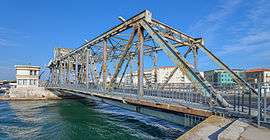 Tivoli bridge | ||
| ||
 Sète Location within Occitanie region  Sète | ||
| Coordinates: 43°24′19″N 3°41′51″E / 43.4053°N 3.6975°ECoordinates: 43°24′19″N 3°41′51″E / 43.4053°N 3.6975°E | ||
| Country | France | |
| Region | Occitanie | |
| Department | Hérault | |
| Arrondissement | Montpellier | |
| Canton | Sète | |
| Intercommunality | CA Bassin de Thau | |
| Government | ||
| • Mayor (2014–2020) | François Commeinhes (UMP) | |
| Area1 | 24.21 km2 (9.35 sq mi) | |
| Population (2008)2 | 42,786 | |
| • Density | 1,800/km2 (4,600/sq mi) | |
| Demonym(s) | Sétois | |
| Time zone | UTC+1 (CET) | |
| • Summer (DST) | UTC+2 (CEST) | |
| INSEE/Postal code | 34301 /34200 | |
| Elevation |
0–176 m (0–577 ft) (avg. 4 m or 13 ft) | |
|
1 French Land Register data, which excludes lakes, ponds, glaciers > 1 km2 (0.386 sq mi or 247 acres) and river estuaries. 2 Population without double counting: residents of multiple communes (e.g., students and military personnel) only counted once. | ||
Sète (French pronunciation: [sɛt]; Seta in Occitan), known as Cette until 1928, is a commune in the Hérault department in the Occitanie region in southern France. Its inhabitants are called Sétois.
Known as the Venice of Languedoc and the singular island (in Paul Valéry's words), it is a port and a seaside resort on the Mediterranean with its own very strong cultural identity, traditions, cuisine and dialect. It is also the hometown of artists like Paul Valéry, Jean Vilar, Georges Brassens, Gregory Del Piero, Hervé Di Rosa, Manitas de Plata, and Robert Combas.
Geography
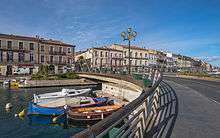
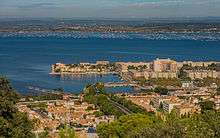
Built upon and around Mont St Clair, Sète is situated on the south-eastern hub of the Bassin de Thau, an enclosed salt water lake used primarily for oyster and mussel fields. To its other side lies the Mediterranean. And the town has a network of canals which are link between the Étang de Thau and the Mediterranean Sea.
Climate
| Climate data for Sète (1981–2010 averages) | |||||||||||||
|---|---|---|---|---|---|---|---|---|---|---|---|---|---|
| Month | Jan | Feb | Mar | Apr | May | Jun | Jul | Aug | Sep | Oct | Nov | Dec | Year |
| Record high °C (°F) | 20.2 (68.4) |
21.3 (70.3) |
27.1 (80.8) |
31.0 (87.8) |
34.6 (94.3) |
35.9 (96.6) |
37.8 (100) |
41.0 (105.8) |
34.2 (93.6) |
32.1 (89.8) |
25.4 (77.7) |
20.4 (68.7) |
41.0 (105.8) |
| Average high °C (°F) | 10.8 (51.4) |
11.6 (52.9) |
14.6 (58.3) |
16.9 (62.4) |
20.6 (69.1) |
24.9 (76.8) |
27.8 (82) |
27.4 (81.3) |
23.7 (74.7) |
19.3 (66.7) |
14.3 (57.7) |
11.4 (52.5) |
18.6 (65.5) |
| Average low °C (°F) | 5.3 (41.5) |
5.5 (41.9) |
7.9 (46.2) |
10.1 (50.2) |
13.8 (56.8) |
17.4 (63.3) |
20.0 (68) |
19.9 (67.8) |
16.8 (62.2) |
13.6 (56.5) |
9.0 (48.2) |
6.2 (43.2) |
12.2 (54) |
| Record low °C (°F) | −11.0 (12.2) |
−12.0 (10.4) |
−6.2 (20.8) |
1.2 (34.2) |
4.2 (39.6) |
6.5 (43.7) |
12.0 (53.6) |
11.0 (51.8) |
6.0 (42.8) |
2.4 (36.3) |
−1.8 (28.8) |
−7.2 (19) |
−12.0 (10.4) |
| Average precipitation mm (inches) | 51.4 (2.024) |
51.8 (2.039) |
39.7 (1.563) |
48.3 (1.902) |
42.3 (1.665) |
25.2 (0.992) |
11.5 (0.453) |
26.4 (1.039) |
56.7 (2.232) |
90.9 (3.579) |
65.2 (2.567) |
51.3 (2.02) |
560.7 (22.075) |
| Average relative humidity (%) | 76 | 74 | 70 | 70 | 72 | 69 | 66 | 68 | 74 | 76 | 75 | 76 | 72.2 |
| Source #1: Météo France[1] | |||||||||||||
| Source #2: Infoclimat.fr (humidity and snowy days, 1961–1990)[2] | |||||||||||||
History
- The name first appeared in:
- July 29, 1666 : the first stone is officially set on the Saint-Louis pier.
- 1681 : completion of the Canal du Midi.
- 1684 : Vauban visits the port.
- 1703 : Saint-Louis church is consecrated.
- 24–26 July 1710 : during the War of the Spanish Succession the British attack Sète, soon fought back by the Duke of Noailles.
- 1710–1711 : Saint-Pierre and Butte-Ronde forts are built.
- 1724 : the townhouse is bought.
- 1744 : building of the Richelieu citadel and the Castellas tower.
- 1807–1809 : the British try to burn the town.
- May 21, 1821 : the first stone of the breakwater is set (finished in 1869).
- June 9, 1839 : opening of the Montpellier-Sète railway.
- May 6, 1872 : establishment of the chamber of commerce.
- 1882–1888 : construction works on the port.
- June 24, 1894 : Sante Geronimo Caserio, Italian Anarchist from Lombardy and apprentice baker in Sète stabs to death president Sadi Carnot in Lyon.
- 1895 : opening of the boy high school, later Lycée Paul Valéry.
- 1901 : electric trams network (used until 1935).
- January 20, 1928 : the name of the town changes from Cette to Sète.
- 1934 : Sète Football Club wins the Ligue 1 and Coupe de France and becomes the first club to win both the same year.
- May 23, 1939 : the SS Sinaïa leaves the port with Spanish Republicans seeking asylum in Lázaro Cárdenas's Mexico.
- November 12, 1942 : the town is occupied by the German troops of the Wehrmacht.
- June 25, 1944 : bombing of Sète's train station, Balaruc-les-Bains's and Frontignan's oil refineries by the American 15th Air Force.
- August 20, 1944 : liberation of Sète.
- July 11, 1947 : The packet steamer SS President Warfield leaves for Palestine with 4 530 Jews who survived the Shoah. The port official M. Leboutet had authorised captain Ike Aronowicz to sail to Colombia and, after 5 days on the Atlantic Ocean, the ship took the name SS Exodus and changed direction towards Palestine. 27 km (17 miles) from the coast, they were stopped by 5 British torpedo boats. 75 passengers accepted asylum in France, while the others were brought to Hamburg via Gibraltar.
- 1960 : the Théâtre de la Mer is built.
- 1962 : opening of the technical college Joliot-Curie
- 1966–1978 : major construction works on the port.
- 1970 : opening of the Museum Paul Valéry.
- 1981–1984 : a new public hospital is built.
- October 31, 1991 : the espace Georges Brassens, a museum dedicated to the singer, opens.
- 2004 : plan to preserve the Lido and prevent further coastal damage.
2005 : creation of a new neighbourhood called Villeroy.
- 2006 : renovation of the espace Georges Brassens.
- January 1, 2007 : the Languedoc-Roussillon manages the port of Sète.
- 2014 :une ville humanitaire, creation of "les Anges de la Rue "
Population
| Historical population | ||
|---|---|---|
| Year | Pop. | ±% |
| 1793 | 8,031 | — |
| 1800 | 6,984 | −13.0% |
| 1806 | 8,438 | +20.8% |
| 1821 | 9,061 | +7.4% |
| 1831 | 10,638 | +17.4% |
| 1836 | 11,648 | +9.5% |
| 1841 | 13,413 | +15.2% |
| 1846 | 19,041 | +42.0% |
| 1851 | 19,124 | +0.4% |
| 1856 | 21,064 | +10.1% |
| 1861 | 22,438 | +6.5% |
| 1866 | 24,177 | +7.8% |
| 1872 | 25,826 | +6.8% |
| 1876 | 28,690 | +11.1% |
| 1881 | 35,517 | +23.8% |
| 1886 | 37,058 | +4.3% |
| 1891 | 36,541 | −1.4% |
| 1896 | 32,729 | −10.4% |
| 1901 | 33,246 | +1.6% |
| 1906 | 33,892 | +1.9% |
| 1911 | 33,049 | −2.5% |
| 1921 | 36,503 | +10.5% |
| 1926 | 37,005 | +1.4% |
| 1931 | 36,953 | −0.1% |
| 1936 | 37,324 | +1.0% |
| 1946 | 31,203 | −16.4% |
| 1954 | 33,454 | +7.2% |
| 1962 | 36,301 | +8.5% |
| 1968 | 40,476 | +11.5% |
| 1975 | 39,258 | −3.0% |
| 1982 | 39,545 | +0.7% |
| 1990 | 41,510 | +5.0% |
| 1999 | 39,542 | −4.7% |
| 2008 | 42,786 | +8.2% |
Patron saint
In 1703, when the Saint-Louis church was consecrated, Louis IX, patron of the port, also became the patron saint of the town. He has been celebrated every year on August 25, with canal jousting competitions, music and fireworks, except during wartime.
Transport
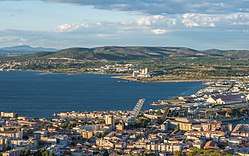
Sète is the eastern starting point of the Canal du Midi, and the ending point of the Canal du Rhône à Sète. Its train station Gare de Sète is approximately 15 minutes by train from Montpellier, and is also served by long distance trains to Bordeaux, Toulouse, Marseille and Paris. Car ferries sail between Sète and Morocco.
Culture
Sète is a centre of water jousting, and hosts a major tournament during the town festival, the St-Louis.
Paul Valéry's poem Le cimetière marin, depicts the graveyard above Sète's harbour. Valéry is buried in the graveyard, and the nearby Paul Valéry Museum contains a collection of his drawings and manuscripts.
Espace Georges-Brassens is a museum dedicated to the Sétois singer-songwriter.
Agnès Varda's first film, La Pointe Courte, was filmed in the environs of Sète.
The Secret of the Grain, also known as Couscous or Le Grain et le Mulet, a César Award-winning movie about Tunisian immigrants, was filmed in Sète.
Notable people
Sète was the birthplace of:
- Paul Valéry (1871–1945), author and poet of the Symbolist school
- Paul-Marie Masson (1882–1954), composer and musicologist
- Jean Vilar (1912–1971), actor and creator of the Avignon theatre festival
- Georges Brassens (1921–1981), singer and songwriter
- Robert Combas (born 1957), sculptor and painter
- Hervé Di Rosa (born 1959), painter and sculptor
- Manitas de Plata (1921-2014), flamenco guitarist
- Gilbert Py (born 1933), Opera singer (tenor)
- Simon Sutour (born 1952), Senator of Gard
- Alain de Pouzilhac (born 1945), CEO of France 24 and former president of France Médias Monde
International relations
Twin towns, sister cities
Sète is twinned with:




Gallery
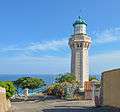 Lighthouse of the Mount Saint-Clair
Lighthouse of the Mount Saint-Clair Théatre de la Mer.
Théatre de la Mer. Fort Richelieu.
Fort Richelieu.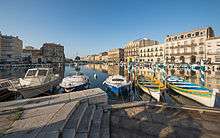 Maréchal de Lattre de Tassigny Embankment.
Maréchal de Lattre de Tassigny Embankment. Sète and the Étang de Thau.
Sète and the Étang de Thau. Tivoli Bridge over one of the canals of the town.
Tivoli Bridge over one of the canals of the town. Crique de l'Anau, a cove in the Mediterranean Sea.
Crique de l'Anau, a cove in the Mediterranean Sea.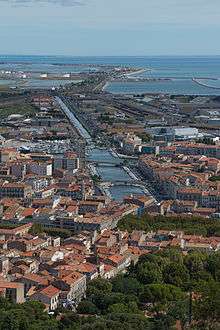 Canal de la Peyrade
Canal de la Peyrade
See also
References
- ↑ "Données climatiques de la station de Sète" (in French). Meteo France. Retrieved January 7, 2016.
- ↑ "Normes et records 1961-1990: Sète (34) - altitude 80m" (in French). Infoclimat. Retrieved January 7, 2016.
- ↑ "British towns twinned with French towns". Archant Community Media Ltd. Retrieved 2013-07-11.
External links
| Wikimedia Commons has media related to Sète. |
| Wikisource has the text of the 1911 Encyclopædia Britannica article Cette. |
- City council website (in French)
.svg.png)